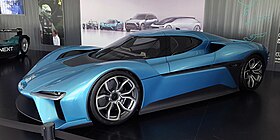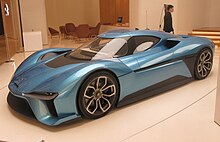Motor vehicle
| Nio EP9 | |
|---|---|
 | |
| Overview | |
| Manufacturer | Nio NextEV Nio Formula E Team RML Group |
| Also called | NextEV EP9 |
| Production | 2016-2019 (80 produced total) EP9 (50 produced) EP9 GT (25 produced) EP9 GT3 Road Version (5 produced) |
| Designer | David Hilton, Ben Payne, Andrew Sheffield |
| Body and chassis | |
| Class | Track day car Sports car (S) |
| Body style | 2-door coupé |
| Layout | individual-wheel drive |
| Powertrain | |
| Electric motor | Indirectly water-cooled motors (one motor at each wheel) |
| Power output | 250 kW (335.25 hp) each wheel 1 MW (1,341 hp; 1,360 PS) total |
| Transmission | 4 individual single-ratio transmissions (one gearbox at each wheel) |
| Battery | lithium ion batteries |
| Electric range | 427 km (265 mi) |
| Dimensions | |
| Length | 4,888 mm (192.4 in) |
| Width | 2,230 mm (88 in) |
| Height | 1,150 mm (45 in) |
| Curb weight | 1,735 kg (3,825 lb) |
The Nio EP9 is a battery-powered, two-seat sports car manufactured by RML Group on behalf of Chinese electric car company Nio. Although it is a track-use only car, it was not developed with assistance from Nio's Formula E racing division. The name EP9 stands for Electric Performance 9.
History
Developed and built in 18 months, the EP9 debuted at the Saatchi Gallery in London, England on November 21, 2016.
Six EP9s have been sold to Nio investors for £2,500,000 each. Nio has announced that ten additional EP9s will be sold to the general public.
However, it is not a road-legal vehicle, and none of the 16-production model EP9s were ever registered for road use. The EP9 is purely designed for track use only and does not comply with the laws and regulations to be registered in China. None of the 16-production model EP9s were ever exported and registered for road use outside China so far.
Specifications
Each of the EP9's wheels has its own motor and transmission. Each motor has 250 kW (335.25 hp), giving the car a total power output of 1 MW (1,341 hp; 1,360 PS). The EP9 is both all-wheel drive, and individual-wheel drive. The car has an advanced torque vectoring system that can adjust the power output to each wheel.
The EP9's battery can last up to 427 km (265 miles) before it needs to be charged. Recharging takes 45 minutes, and battery replacement takes 8 minutes as the batteries need to be removed when recharged.
The car is equipped with an active suspension, including a ride height controller that makes 200 calculations per second.
The car's brakes are developed and constructed by U.K manufacture Alcon.
The car's chassis construction is all carbon fibre, and is based on the FIA Le Mans Prototype regulations. The exterior is also made of the same material.
The vehicle's batteries weigh 635 kg (1,400 lb). All of the carbon fibre in the car, in total, weighs 364 kg (802 lb). The total weight of the car is 1,735 kg (3,825 lb).
Performance
The EP9 can accelerate from 0 to 100 km/h (62 mph) in 2.7 seconds, 200 km/h (124 mph) in 7.1 seconds, and 300 km/h (186 mph) in 15.9 seconds, as demonstrated by Richard Hammond in The Grand Tour. The car can achieve a top speed of 313 km/h (194 mph).
The EP9 can also brake at a very short distance, as Richard Hammond (who had compared its acceleration to two vehicles he had famously crashed, a Rimac Concept One and the jet-powered dragster) demonstrated at the Eboladrome.
The car is somewhat capable of autonomous driving, which it did when the car set a record for fastest autonomous driving at the Circuit of the Americas. However, this was only possible because it was configured to drive autonomously.
Design



The EP9's chief designer was David Hilton, who was also Nio's former senior design director.
Exterior
The EP9's rear wing is adjustable between three settings: parked, low-drag, and high-downforce. The EP9 produces 24,000 newtons (5,395 lbs or 2447 kg) of downforce at 240 km/h (149 mph), similar to a Formula One car, allowing the EP9 to corner at 3.0 Gs.
Interior
The interior, like the exterior and chassis, is made entirely of carbon fibre. There are four screens: one on the driver's side of the dashboard, one on the passenger's side of the dashboard, one on the centre console, and one on the steering wheel.
- Dashboard screens - Both screens display performance data, but differ in function. The passenger-side screen displays only four measurements: the car's top speed, lap time, and lateral G-forces, and the driver's heart rate.
- Centre console screen - Displays performance data, lap times, and a track map with the car's current position.
- Steering wheel screen - The steering wheel is a simplified version of Nio's Formula E racing wheel, and is built by the same company.
World records
The EP9 set the record for the fastest lap by an electric vehicle for the Circuit of the Americas, Shanghai International Circuit and the Circuit Paul Ricard tracks. It also set the record for the fastest lap by an autonomous vehicle at the Circuit of the Americas track.
| Track | Lap Time | References |
|---|---|---|
| Circuit Paul Ricard | 1:52.78 | |
| Circuit of the Americas | 2:11.30 (driver) 2:40.33 (auto) |
|
| Shanghai International Circuit | 2:01.11 |
The EP9 used racing slicks for all of the record attempts.
See also
- List of production cars by power output
- Aspark Owl
- Rimac Concept One
- Tesla Roadster (2020)
- Volkswagen I.D. R
- Lotus Evija
- McMurtry Spéirling
References
- "Electric vehicle". United States Patent and Trademark Office. Retrieved 18 May 2023.
- Winton, Neil (21 November 2016). "China's NextEV Launches NIO Brand And World's Fastest Electric Car". Forbes. Retrieved 23 August 2024.
- DPCcars (22 November 2016), NextEV NIO EP9 With 1341 Horsepower Unveiling, retrieved 23 February 2017
- ^ "NIO EP9 model specification". www.nio.com. NIO. Retrieved 21 February 2017.
- caroto_gr (27 November 2016), NextEV Nio EP9 - 1 360hp World's Fastest Electric Car, retrieved 23 February 2017
- "Design Story: NIO EP9 Supercar: The Brand Ambassador". FormTrends.com. 13 June 2017. Retrieved 5 October 2020.
- FIA Formula E Championship (4 December 2016), NIO EP9: The Fastest EV Supercar In The World - Formula E, retrieved 23 February 2017
- "2017 NIO EP9 - Image #11". Caricos.com. Retrieved 24 February 2017.
- "2017 NIO EP9 - Image #15". Caricos.com. Retrieved 24 February 2017.
- "2017 NIO EP9 - Image #17". Caricos.com. Retrieved 24 February 2017.
- "NIO EP9 Sets World Record Nürburgring EV Lap Time". MotorTrend.ca. 22 November 2016.
- "The Nio EP9 Just Clocked An Autonomous Lap Record, With A Slight Catch". Car Throttle. Retrieved 3 March 2017.
- "NIO's all-electric supercar reached a top speed of 160 mph and completed record lap without any driver". Electrek. 27 February 2017. Retrieved 27 February 2017.
- "NIO EP9 continues to smash lap records". e-racing.net. 21 March 2017. Retrieved 27 May 2017.
External links
| Nio | ||
|---|---|---|
| Marques | [REDACTED] | |
| Current Nio vehicles | ||
| Current Onvo vehicles | ||
| Concept vehicles | ||
| Joint ventures |
| |
| Racing |
| |
| Nio automobile timeline, 2016–present | ||||||||||||||||||||||||||||||||||||||||||||||||||||||||||||||||||||||||||||||||||||||||
|---|---|---|---|---|---|---|---|---|---|---|---|---|---|---|---|---|---|---|---|---|---|---|---|---|---|---|---|---|---|---|---|---|---|---|---|---|---|---|---|---|---|---|---|---|---|---|---|---|---|---|---|---|---|---|---|---|---|---|---|---|---|---|---|---|---|---|---|---|---|---|---|---|---|---|---|---|---|---|---|---|---|---|---|---|---|---|---|---|
| ||||||||||||||||||||||||||||||||||||||||||||||||||||||||||||||||||||||||||||||||||||||||